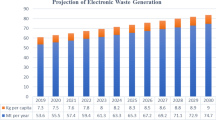Abstract
Waste disposal systems conventionally exhibit many problems, such as difficulties in finding final disposal sites for incinerator residues and the issue of how to recycle waste materials. Some new technologies have been developed to solve such problems, including ash melting and gasification melting. Furthermore, to improve the power generation efficiency of waste treatment facilities so that their energy is used more efficiently, combined stoker/gas turbine power generation (super waste power generation) technology has been developed. Through examination of two cases in this study, environmental impacts and costs were determined using lifecycle assessment (LCA) and lifecycle cost (LCC) methods in a model city. In case 1, a stoker furnace was compared to a combined stoker/gas turbine system. In case 2, a stoker furnace plus ash melting system was compared to a gasification melting system. The results demonstrate that the stoker furnace has a lower environmental impact than the combined stoker/gas turbine system in case 1, and that the stoker plus ash melting system costs less than the gasification melting system in case 2, but both systems had strong impacts on the environment.
Similar content being viewed by others
References
Research on residual volume of final disposal sites for municipal waste. In: Database of waste issue examination committees in eight prefectural capital cities. http://www.8tokenshi.jp/index.html. Accessed July 14, 2008
The Ministry of the Environment (2003) Investigating results of municipal waste disposal. The Ministry, Tokyo
Terashima H (2005) Technical trend of refuse incineration technology. Urban Municip Waste 3:25–29
Michihiko T (2005) Waste disposal and global warming: a practical case of high-efficiency waste power generation. J Jpn Waste Manag Assoc 258:172–175
Nagamura K (1998) Study of refuse disposal system composed of new technologies. Waste Manag Res 7:496–508
Letter “Clean Association of TOKYO 23” (2004):2
Tanigawa N (1998) Waste incineration: the threshold of change. Development of new waste-to-energy technology. Waste Manag Res 7:470–486
(2005) Statistics on municipal waste of city A 2004. 4–35
Osaka Prefectural Government (2006) Database of municipal waste in Osaka Prefectural Government (2006). http://www.pref.osaka.jp/waste/gomi/data_H15.html. Accessed July 14, 2008
Global Environmental Bureau of the Ministry of the Environment (2004) Calculation guidelines of greenhouse effect gas emissions from business 2–51. The Bureau, Tokyo
Think TankTama and Toshi (2004) The present conditions of city, town and village waste disposal treatment analyzed using LCA and costs. J Solid Liquid Waste 34:35–50
Wada Y (2004) Research report on polyvinyl chloride (PVC). Faculty of Engineering, Kansai University
National Institute for Environmental Studies (2004) Embodied energy and emission intensity data for Japan using input-output tables. http://www-cger.nies.go.jp/publication/D031/index_skip-j.html
Architectural Institute of Japan (2004). In: LCA database of the Architectural Institute of Japan. http://news-sv.aij.or.jp/tkankyo/s0/news.htm
Matsuto T, Tanaka N, Kim Y (1996) Energy, cost, and environmental impact analysis of five RDF production facilities. Waste Manag Res 2:68–77
Ministry of Land, Infrastructure and Transport, Government of Japan (2005) Specified labor rates for public works 2004 (in Japanese). http://www.mlit.go.jp/kisha/kisha04/01/010323/01.pdf. Accessed July 14, 2008
Wada Y (2004) Hearing concerns of City C
Osada M, Fujiyoshi H (2005) Landfill site reclamation technology and its economic evaluation. Waste Manag Res 3:142–149
Author information
Authors and Affiliations
Corresponding author
Rights and permissions
About this article
Cite this article
Wada, Y., Okumoto, T. & Wada, N. Evaluating waste disposal systems. J Mater Cycles Waste Manag 10, 173–187 (2008). https://doi.org/10.1007/s10163-008-0209-1
Received:
Accepted:
Published:
Issue Date:
DOI: https://doi.org/10.1007/s10163-008-0209-1




